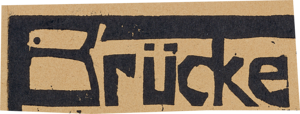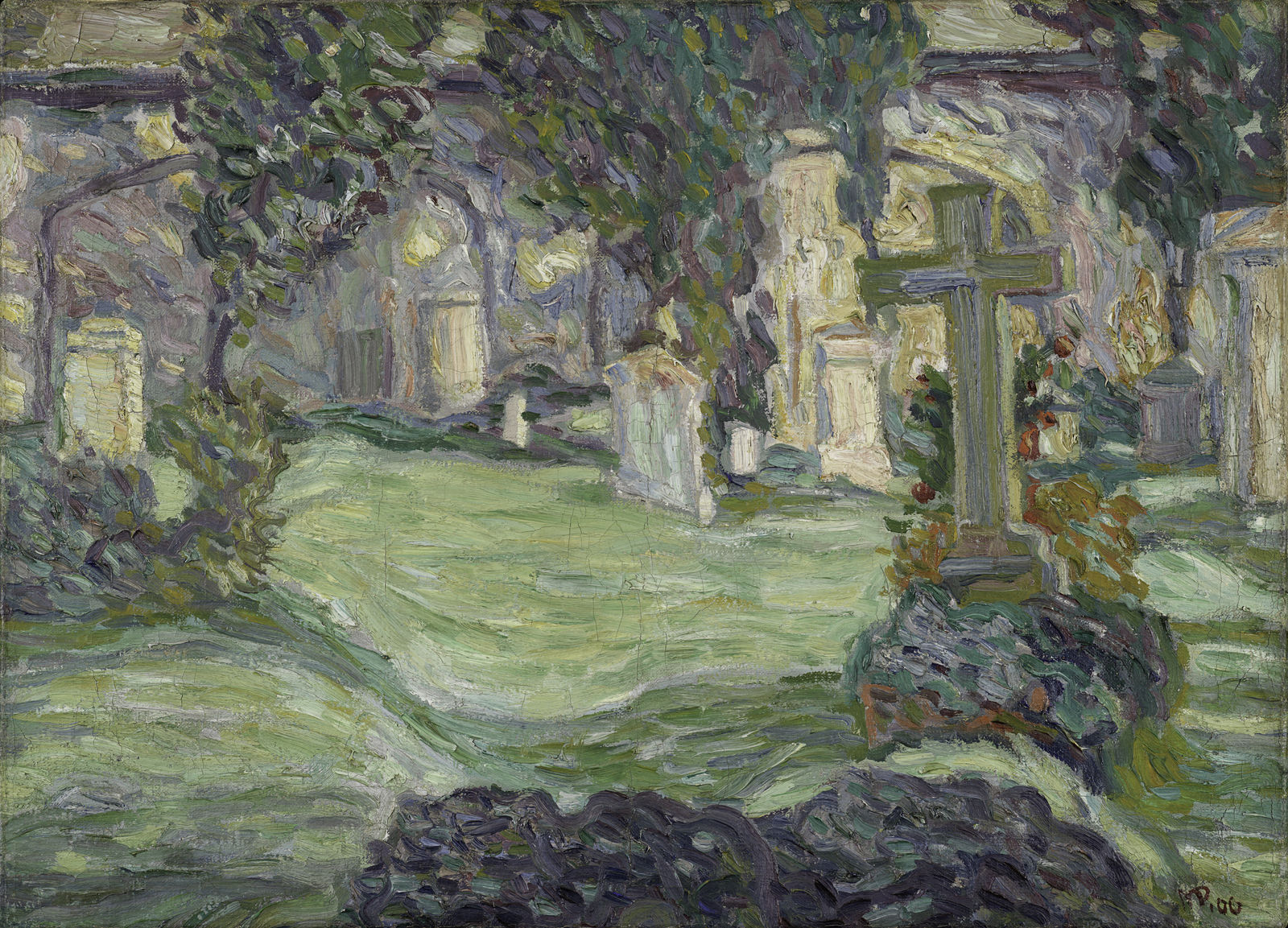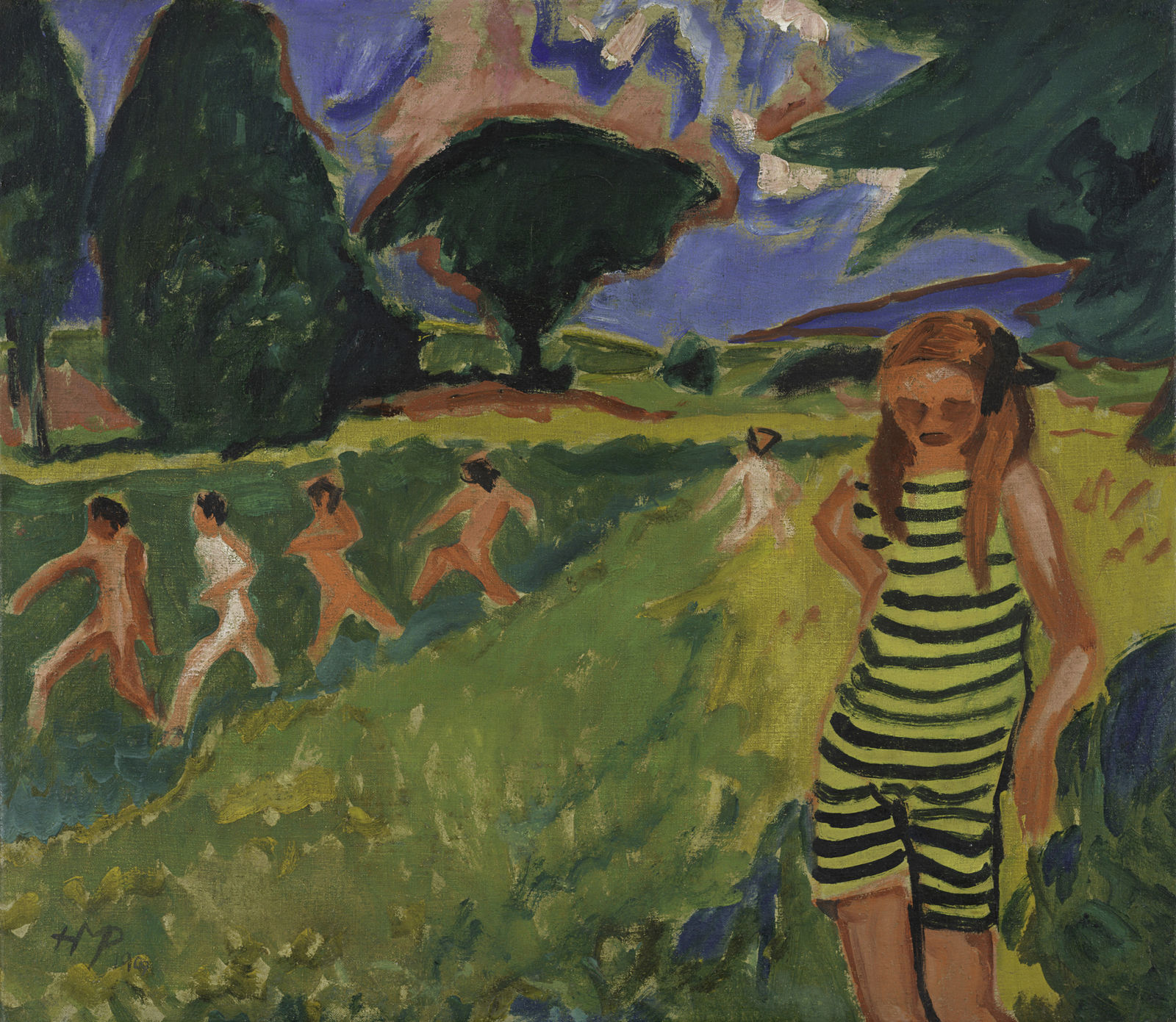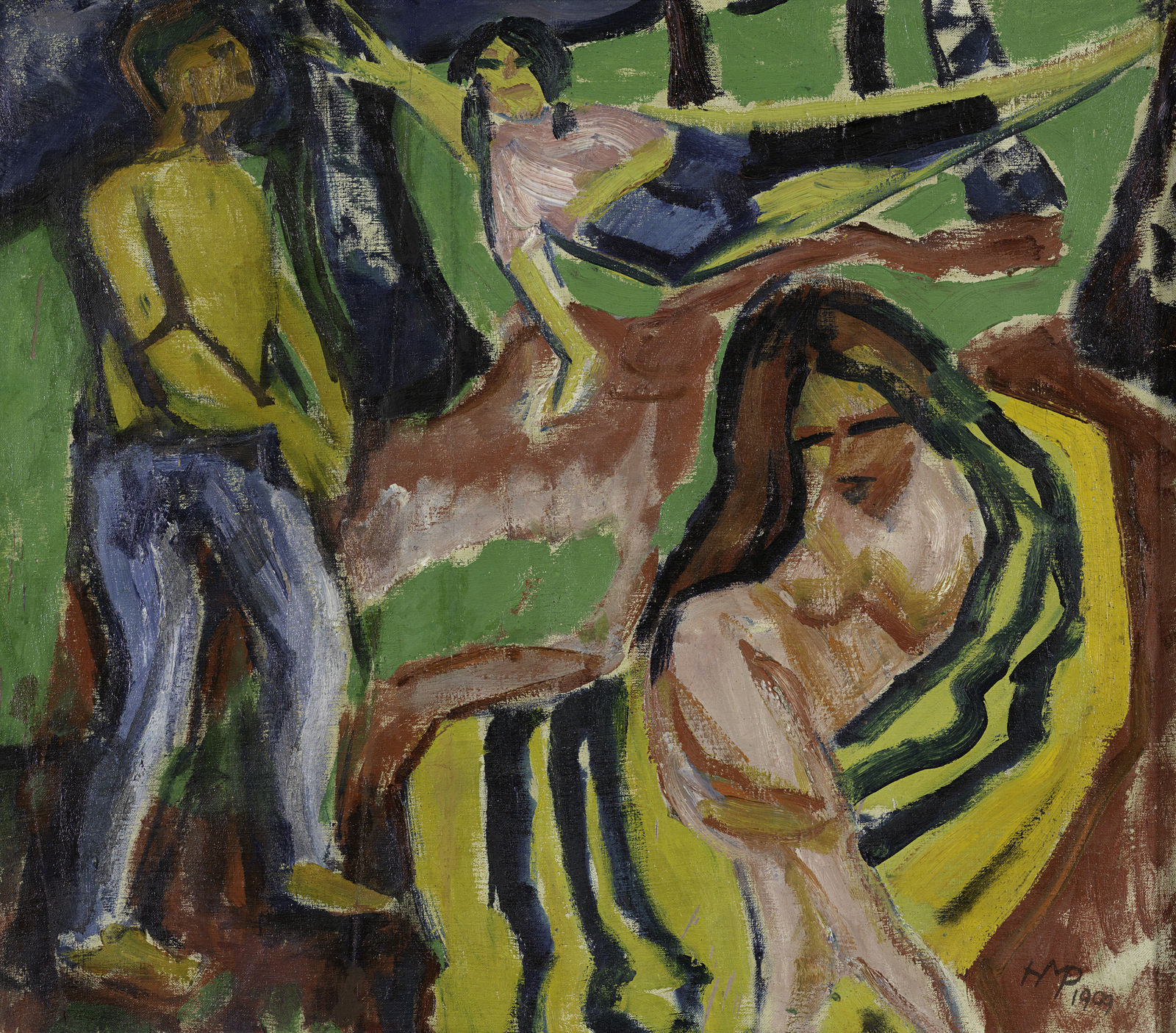Artist
Max Pechstein
Born
31 December 1881, Zwickau, Germany
Died
29 June 1955, Berlin, Germany
Biography
The early years – between applied art and fine art (1881–1906)
Hermann Max Pechstein grew up in a working-class family of social democratic persuasion in Zwickau, Saxony. He was one of the seven children of Hermann Franz Pechstein, who worked in a textile factory, and his wife Lina Pechstein, née Richter. Even as a child, Max Pechstein wanted to become an artist and was supported in his aspirations by his uncle, who painted in his spare time. In 1886, he began studying under a Zwickau-based master painter. Later, in October 1900, he enrolled on a degree course at the Royal Academy of Applied Art in Dresden, from which he graduated in 1903. Shortly afterwards, he moved to the city’s Royal Academy of Fine Arts, where he took masterclasses from Otto Gussmann, professor of decorative painting. Pechstein worked for Gussmann during his studies, assisting with murals, glazing, mosaics for churches and public buildings. At that time, his works were still influenced by Art Nouveau.
Member of the Brücke and artistic breakthrough (1906–1914)
In the spring of 1906, Pechstein contributed a ceiling design to the Third German Arts and Crafts Exhibition in Dresden. It was here that he met Erich Heckel, and he got to know the other Brücke artists shortly afterwards. In them, he found likeminded individuals and decided to join the group. Pechstein was even included in the first Brücke exhibition at Dresden’s Seifert lighting factory in September 1906, to which he contributed a few sketches in oil. For the second exhibition at the same location in December 1906, he designed the exhibition poster. Parallel to his involvement with the Brücke, he continued to keep himself afloat by taking on jobs in the applied arts, and in the autumn of 1907 he completed his degree – the only Brücke painter at that time to have completed an academic education. Directly afterwards, he spent several months travelling through Italy and France, which he was able to do thanks to a travel bursary, the Saxon State Prize. In Italy, he studied the works of the Renaissance, while in France he became interested in current artistic developments, such as the Fauves. The simplified forms, intense colour palette and the unmixed, directly applied paint he saw here inspired him in his own work. In August 1908, Pechstein decided to leave Dresden and to move to Berlin. At the beginning of 1909 he met 16-year-old Charlotte Kaprolat, who posed as his model for several works. Shortly afterwards, they became a couple and they married two years later. In April 1909, Pechstein was represented by three paintings in the spring exhibition of the Berlin Secession for the first time, an event that he himself in retrospect considered his artistic breakthrough. In the following year, however, his works were rejected by the Secession, and he subsequently teamed up with other rejected artists such as Erich Heckel, Ernst Ludwig Kirchner and Karl Schmidt-Rottluff to establish a new exhibition community: the New Secession, of which he took over management together with artist Georg Tappert. In 1911, the other Brücke member artists also moved to Berlin. Together with Kirchner, in the autumn of 1911 he planned to open a private painting school, the MUIM Institute (Moderner Unterricht in Malerei – “modern tuition in painting”), but they were unable to achieve the success they were hoping for. In December, Pechstein left the New Secession and exhibited in a Berlin Secession exhibition once again instead. This met with disapproval from the Brücke artists, who subsequently excluded him from the group. Nevertheless, he was able to gain a further foothold as an artist, staging his first solo exhibition in February 1913 with Gurlitt in Berlin, who from then on took him under exclusive contract. In June of the same year, his son Max Frank was born.
Travel to the Pacific and the First World War (1914–1918)
In early 1914, Pechstein began planning a two-year journey to the western Pacific. His destination was the archipelago of Palau, which had been part of the colony of German New Guinea since 1899 but has been ceded to the Japanese during the First World War in 1914. Pechstein had been fascinated by the Pacific culture and aesthetics of Palau even while he was part of the Brücke. He and the other Brücke artists had painted in the Dresden Museum of Ethnology and studied the balconies of Palau buildings with reliefs, subsequently incorporating this aesthetic into their own works. He hoped that his trip would give him access to a “paradisiacal primitiveness” that he believed had been lost in Europe. In his mind, Palau became a romanticized and exotic utopia, although he gave little thought to the problems of German colonization and his own colonial perspectives. On 9 May 1914, he left Berlin with his wife and by 21 June they eventually reached Angaur, the most southerly of Palau’s islands, from where they continued to travel to other parts of the archipelago. He studied ornate wooden houses, jewellery and everyday life – everything he saw he captured in sketches, carving and paintings. For Pechstein, it was not enough merely to observe the local people in their activities; he also tried to imitate their way of life, so he hunted and fished, and even made his own spears for the purpose. Nevertheless, he was still trapped in the colonial mindset of the day and kept a local servant. News of the outbreak of the First World War on 1 August 1914 only reached him three days later, and the information he received about the actual events was delayed and fragmented. In October 1914, the Pechsteins were taken prisoners of war by the Japanese and had to leave Palau. In 1915, they were released and made it back to Germany via a rather circuitous route. Once home, Pechstein began publishing his travel experiences in newspaper articles, but in September of the same year, he was conscripted into the army and sent to the western front. Stationed in Flanders, he was removed from the foremost front initially to paint a portrait of a commanding officer and later to work as a cartographer. In May 1917, he was posted to Berlin to join the air force and trained as an image analyst. He was able to work at home and therefore started producing art again. The resulting works included many depicting Palau, some of which were exhibited by Gurlitt in July of the same year.
Political commitment and new reputation as an artist (1918–1933)
With the end of the First World War, Pechstein became politicized and was involved in the November Revolution. He welcomed the political upheaval and became committed to a peaceful revolution aimed at establishing social democracy. He was a co-initiator of the November Group, an association of artists who supported the social revolution in Germany. At the same time, he was involved in the left-leaning “Arbeitsrat für Kunst” (Works Council for Art), which worked to make art and architecture accessible to a broader population. He spent the summer months of the 1920s in Nida on the Curonian Spit and on Łebsko Lake in Pomerania, where he produced studies of nature as well as paintings of rural life. In December 1921, he divorced his wife Charlotte and began a relationship with Marta Möller, whom he married in September 1923. This year also saw him part ways with his art dealer Gurlitt, resulting in a court battle over the works still in Gurlitt’s possession. This signalled the end of a crucial degree of socio-economic security for Pechstein. In October 1923, he was made a member of the Prussian Academy of Art, and two years later also joined its exhibition committee. His works made their way into public collections, such as that of the Crown Prince’s Palace in Berlin, and he was regularly represented nationwide in both group and solo exhibitions. Alongside his independent artistic activities, he also took on further applied art commissions: In the winter of 1925, for example, he designed stage sets for Deutsches Theater in Berlin, and in the following spring he was commissioned by the German government to design glazing for the International Labour Office in Geneva.
Artistic work and outlawing under the Nazis (1933–1945)
Pechstein came under critical scrutiny even in the early stages of the Nazi period. The situation was different for his former Brücke colleagues Schmidt-Rottluff and Heckel, who met not only with rejection but also support from some areas of the reactionary circles in the Völkisch movement. Pechstein’s involvement with left-leaning groups during the interwar years helped ensure his work was the subject of particular mistrust by the Nazis, and he himself was critical of the Nazi regime right from the start, rejecting its racist ideology. He bemoaned the fate of his Jewish friends and collectors, who had been forced into exile, and continued to support them. In the spring of 1933, Emil Nolde denounced Pechstein to the Reich Ministry of Public Enlightenment and Propaganda as a Jew, an inaccurate piece of information on which Pechstein was henceforth forced to provide statements and as a result of which he had to submit so-called proof of descent earlier than many others. The 1930s were a difficult time for him economically, as he earned less than his artist colleagues, but in spite of his being forbidden from his exercising chosen profession he still staged some solo exhibitions. In June 1937 – shortly before the opening of the “Degenerate Art” exhibition in Munich – he displayed works in a show that was staged by the Nazi leisure organization “Strength through Joy” at the Auto Union AG in Chemnitz. Unlike his former Brücke colleagues, he even got an exhibition at Berlin’s Galerie van de Heyde in May 1939, the first exhibition of works by an artist denounced as “degenerate” by the Nazis since 1937. Like many others, Pechstein was hard-hit by the seizure of modern art from German museums in summer 1937, and some of the confiscated works were presented for public scorn in the “Degenerate Art” touring exhibition. The political developments in Germany contributed to Pechstein’s decision to regularly spent the summer months of the years during the 1930s and 40s in a fishing village on Lake Koser in Pomerania. Following the destruction of his Berlin apartment, in spring 1944 he moved to Leba (now Łebsko) in Pomerania, and during the course of the bombing raids of the capital many of his works were lost. In August 1944, the Pechsteins were conscripted to perform forced labour on the Pomeranian Wall, which was supposed to prevent the advance of the Red Army.
Artistic rehabilitation and university teaching (1945–1955)
During the post-war period, Pechstein earned an income in Leba by doing auxiliary work for Russian and Polish soldiers. He returned to Berlin on 30 September 1945, and just one day later he received an offer from painter and university rector Karl Hofer to teach at the Berlin University of Fine Arts. As early as 1945, the Allies were already working to rehabilitate the artists who had been denounced by the Nazis, and Max Pechstein was no exception. As a result, in July 1945 he was represented in the first exhibition by the Kammer der Kunstschaffenden, a “chamber of artists”, the first large-scale exhibition after the Second World War. Many other exhibitions followed, both in Berlin and nationwide. In August 1946, Pechstein was a member of the jury for the General German Art Exhibition in Dresden, to which he also contributed his own works. The presentation was one of the most important exhibitions in post-war Germany and was to be the first post-war art exhibition representing the whole of Germany – indeed it was also the last until 1990. In July 1947, Pechstein was made an Honorary Citizen of the City of Zwickau, and at the same time the city authorities launched the Max Pechstein Prize, a bursary for young artists, which still exists to this day. In 1948 and 1953 his work went on display at the Venice Biennale. On 19 November 1949, he was appointed full professor and director of a masterclass in painting at the Berlin Academy, where he had already been teaching for four years. From 1950 onwards, Pechstein had to battle almost constantly with ill health; thrombosis was followed three years later by a bout of tuberculosis. In December 1952, he became the first painter to be awarded the Grand Cross of the Federal Republic of Germany, marking his 71st birthday. He died from the effects of his tuberculosis on 29 June 1955.
Isabel Fischer
Bibliography
Aya Soika, Max Pechstein. Das Werkverzeichnis der Ölgemälde, vol. 1: 105-1918 / vol. 2: 1919-1954, edited by the Max Pechstein copyright holders, Munich: Hirmer Verlag, 2011.
Max Pechstein, Erinnerungen: mit 105 Zeichnungen des Künstlers, edited by Leopold Reidemeister, Wiesbaden: Limes Verlag 1960.
Max Pechstein. Künstler der Moderne. exhib. cat.: Bucerius Kunstforum, Hamburg, edited by Magdalena M. Moeller and Kathrin Baumstark, Munich: Hirmer Verlag, 2017.
Magdalena M. Moeller, Max Pechstein. Pionier der Moderne, exhib. cat. Brücke-Museum, Munich: Hirmer Verlag, 2015.
Max Pechstein auf Reisen. Utopie und Wirklichkeit, exhib. cat. Kunsthaus Stade, Kunstsammlungen Zwickau, Museum im Kulturspeicher Hamburg, edited by Sebastian Möllers, Petra Lewey and Marlene Lauter, Munich: Hirmer Verlag, 2012.
Flucht in die Bilder? Die Künstler der Brücke im Nationalsozialismus, exhib. cat., Brücke-Museum, edited by Aya Soika, Meike Hoffmann and Lisa Marei Schmidt, Munich: Hirmer Verlag 2019.
Max Pechstein. Das ferne Paradies. Gemälde, Zeichnungen, Druckgraphik, exhib. cat. Stästisches Kunstmuseum Spendhaus Reutligen, edited by Städtisches Kunstmuseum Spendhaus Reutlingen, Ostfildern-Ruit: Verlag Gerd Hatje, 1995.






